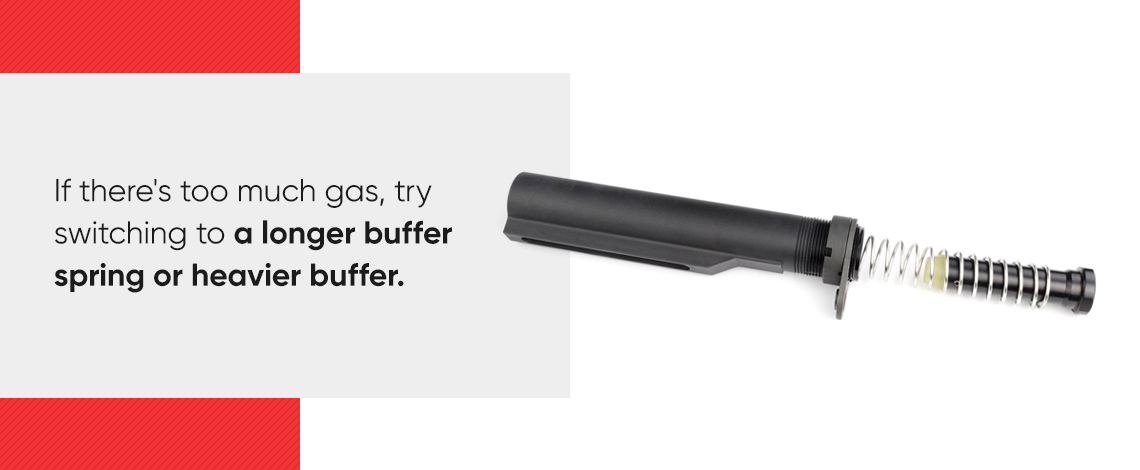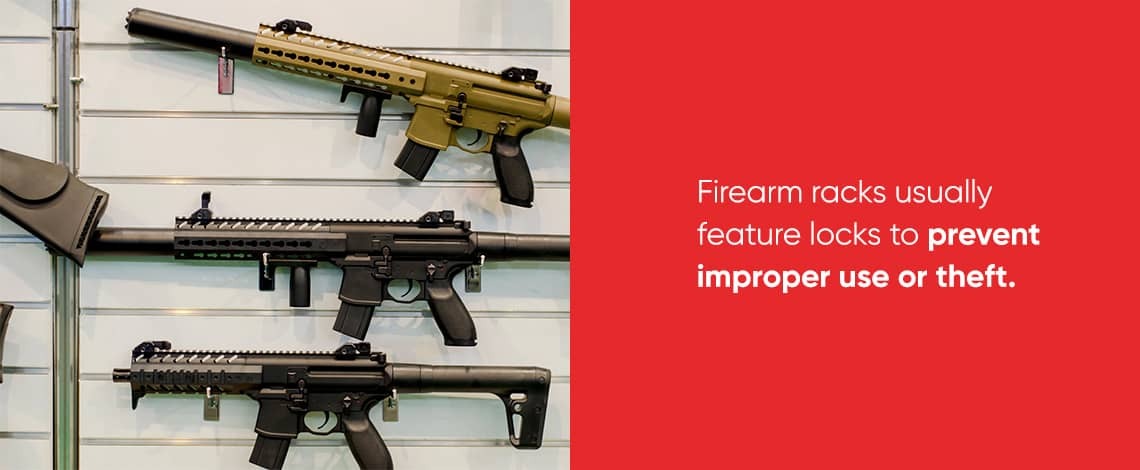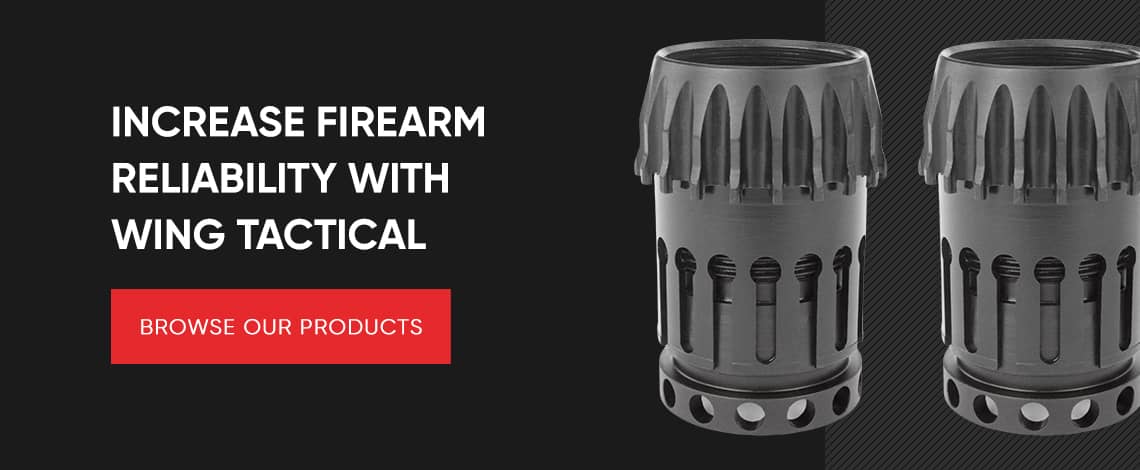
An AR-15 is renowned for its remarkable dependability. You can expect it to provide you with many years of reliable service.
There are numerous things you can do to increase AR-15 reliability. Some involve basic preventive maintenance, while others entail the choices you make in terms of setting up and using your firearm.
AR-15 Cleaning Tips
As with most mechanical objects, an AR-15 requires regular cleaning to keep it in peak operating condition. The more frequently you use your gun, the more often you will need to clean it. Specifically, you should focus your cleaning efforts on the bolt carrier group to maximize AR-15 reliability.
Fortunately, the AR-15 is relatively easy to clean. The basic steps involve removing and disassembling the bolt carrier group and scrubbing the parts with a high-quality gun oil. Be sure to clean the area thoroughly between the bolt and barrel to eliminate excess carbon build-up.
Lubrication
Along with regular cleaning, proper lubrication will make an AR-15 more reliable in the long run. The typical AR-15 contains multiple lubrication points such as the bolt carrier, firing pins, gas rings, bolt lugs and cam pins. Clean the firearm thoroughly before lubricating and refer to your firearm's manual if you're unsure about your AR-15's lubrication points.
The lubricant you use largely depends on your environment. For instance, a dry lube works best if you use your AR-15 in dry, dusty or sandy conditions. A heavy lube, on the other hand, may become excessively thick in extreme cold.
Modifications to Increase Reliability

Like proper cleaning and storage, certain AR-15 upgrades can also enhance reliability. Here are some helpful AR-15 modifications to consider.
Gas Ring Replacement
Replacing the gas rings is sometimes necessary to increase AR-15 reliability. A good method for testing your firearm's gas ring is extending the bolt from the bolt carrier group and placing it on a flat surface. If the bolt is unable to support the weight of the carrier group, it is time to replace the gas rings.
High-Quality Magazines
You may be tempted to use a cheap, poor-quality magazine in an effort to save a little money. However, these have a tendency to warp, bend or crack over time. This often results in inefficient ammo feeding and unreliable firing performance. Likewise, the quality of the ammo you use will also directly impact AR-15 reliability. Steer clear of the inferior ammo that is often sold at gun shows.
If you have worn or cheap magazines that still function, you can use them for lower-priority situations like plinking and drills. It's better to save your higher-quality magazines for circumstances that require optimal reliability.
Proper Gas Port Size
Over-gassing is a common AR-15 problem that is typically caused by an oversized gas port. Over-gassing can cause a live ammo round to enter the chamber before a case has a chance to exit fully, which can lead to malfunctions. If you are rebuilding an AR-15, be sure to choose the correct gas port size for your gun.
CHF Barrel
A cold hammer-forged (CHF) barrel offers incredibly long service life and durability. Many CHF barrels can outlast others by several thousands of rounds, maintaining accuracy throughout their life.
The Spike's Tactical CHF barrel starts as a barrel blank loaded onto a rifled mandrel. It becomes harder and sturdier with cold hammer forging. The grooves and lands transfer to the barrel's interior. The rifling grows even more durable with a thick interior chrome finish.
Protective Coating
Protective coating is one of the most obvious and foolproof ways to preserve your AR-15's longevity, especially in moisture- or friction-prone environments. Cerakote, for instance, is a common protective gun coating. It's a low-maintenance, ceramic-based coating that comes in a range of colors.
Unlike other finishes, a Cerakote coating provides superb heat reduction properties, optimal lubricity for treated parts and high scratch and impact resistance. It also won't attract abrasive dust particles. You can apply Cerakote to all materials including metal, plastic and composite surfaces. It should last years before requiring a touch-up.
A nickel boron coating also allows for improved lubricity and easy cleaning. It has high corrosion resistance as well as a silvery metallic look.
New Springs
Worn-out magazines aren't the only culprit of AR-15 malfunctions. High-quality rifle springs are essential as well, especially since the extractor and buffer springs face considerable wear and tear over time.
When changing out your springs, ensure they aren't too light or heavy for the AR-15's gas system to function correctly. You should also get in the necessary range time to determine whether the new springs work properly.
Recommended AR-15 Gas Pressure

In an effort to cycle cheap, inconsistent ammunition, some AR-15 manufacturers intentionally over-gas their firearms. Cycling large amounts of ammo can be a good thing, but too much gas pressure can cause negative effects like:
- Heavier felt recoil
- Premature part wearing
- Damage to the rim of the spent brass
The spent brass's ejection pattern can help you determine how much your firearm is gassed. Look down over the top of your AR-15 with the muzzle at 12:00 and the buttstock at 6:00. Brass ejection near the 3:00 and 4:30 positions indicates sufficient gassing. If the brass ejects ahead of the 3:00 position, that indicates excessive gas. Meanwhile, ejecting behind the 4:30 position suggests insufficient gas.
There are several options for adjusting the gas pressure. If there's too much gas, try switching to a longer buffer spring or heavier buffer. If there's too little gas, check for the following:
- Loose gas block or gas key
- Missing or worn gas springs
- Cracked gas tube
You can also try switching to a shorter buffer spring or a lighter buffer. If these methods don't work, try installing an adjustable gas block for easy gas pressure control.
AR-15 Storage Tips
Aside from cleaning and lubrication, proper storage should be a top priority for any firearm owner. There is an array of storage options to consider, but every gun owner and situation is different. Factor in your accessibility requirements and preferences, budget and local gun safety laws when deciding how to store your AR-15.
If you have an AR-15 for home protection, safety and accessibility are critical even when the firearm isn't in use. Here are some different AR-15 storage options and their pros and cons.
1. Gun Lock
An AR-15 gun lock is an affordable, easy-to-use storage option. Trigger shoes fit around the housing to prevent it from being pulled. Cable locks are then placed through the action or barrel to prevent loading and firing.
While trigger locks can keep the firearm from being fired, their main drawback is that they don't ensure protection from theft. Generally, experts recommend trigger locks as an added safety precaution to the other storage options below.
2. Firearm Case
Firearm cases come in a variety of prices as well as hard-sided and soft-sided styles. They feature some padding to protect the gun from physical damage, but they offer minimal safety and no theft protection. Firearm cases are suitable for short-term storage and transportation when hunting or shooting at a range.
3. Firearm Rack

Designed for storing rifles and pistols, firearm racks usually feature locks to prevent improper use or theft. While not quite as foolproof as a gun safe, they take up far less space and accommodate a wide variety of firearms. Hunting vehicles are often equipped with firearm racks to secure the guns and prevent accidental discharge.
4. Firearm Cabinet
Firearm cabinets are more lightweight than safes and can be easily moved by two people. The cabinet should be permanently mounted to a floor or wall with hardware, which most manufacturers include. Firearm cabinets have the benefit of holding multiple guns compared to most cases that can only accommodate one firearm. They also cost far less than safes. However, firearm cabinets usually aren't fire-resistant.
5. Gun Safe
Gun safes are by far the most secure storage option for AR-15s. Similar to firearm cabinets, be sure to secure a safe with mounting hardware from the manufacturer to prevent theft. Most gun safes have customizable interiors to include shelves or firearm racks for additional AR-15 storage benefits.
Most AR-15 safes are protected with electronic keypads, dials or fingerprint readers. The price can also vary by factors like:
- Construction style
- Fire protection level
- Type of locking mechanism
- Number of locking bolts
Ammo Storage Tips
Modern ammunition can last for decades with correct storage. Heat is the biggest enemy of primer and powder, so be sure to keep your ammo out of sunlight and store it at household temperatures or cooler.
Aim for a dark, dry and cool — but not cold — storage area for ammo. A home closet is ideal. Try to avoid locations prone to extreme temperature fluctuations, like attics and basements. Normal household temperature fluctuations, however, are generally safe for ammo.
Increase Firearm Reliability With Wing Tactical
From having the right AR-15 cleaning products to correctly storing your ammo and firearm, there's plenty you can do to extend your gun's life span. Whether you need AR-15 maintenance tips or high-quality parts and accessories, turn to Wing Tactical. Browse our AR-15 parts or contact us with any questions about cleaning, storing or maintaining your firearm.
